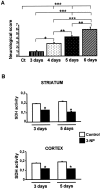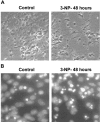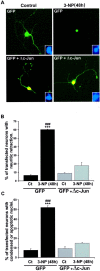The mitochondrial toxin 3-nitropropionic acid induces striatal neurodegeneration via a c-Jun N-terminal kinase/c-Jun module
- PMID: 11896157
- PMCID: PMC6758250
- DOI: 10.1523/JNEUROSCI.22-06-02174.2002
The mitochondrial toxin 3-nitropropionic acid induces striatal neurodegeneration via a c-Jun N-terminal kinase/c-Jun module
Abstract
Impairments in mitochondrial energy metabolism are thought to be involved in most neurodegenerative diseases, including Huntington's disease (HD). Chronic administration of 3-nitropropionic acid (3-NP), a suicide inhibitor of succinate dehydrogenase, causes prolonged energy impairments and replicates most of the pathophysiological features of HD, including preferential striatal degeneration. In this study, we analyzed one of the mechanisms that could account for this selective 3-NP-induced striatal degeneration. In chronically 3-NP-infused rats, the time course of motor behavioral impairments and histological abnormalities was determined. Progressive alterations of motor performance occurred after 3 d. By histological analysis and terminal deoxynucleotidyl transferase-mediated biotinylated UTP nick end-labeling staining, we found a selective neurodegenerescence in the striatum, occurring first in its dorsolateral (DL) part. Activation of c-Jun N-terminal kinase (JNK) was analyzed from brain sections of these rats, using immunocytochemical detection of its phosphorylated form. Activation of JNK occurred progressively and selectively in the DL of the striatum and was followed by c-Jun activation and expression in the same striatal region. To elucidate the role of the JNK/c-Jun module in 3-NP-induced striatal degeneration, we then used primary striatal neurons in culture, in which we replicated neuronal death by application of 3-NP. We found strong nuclear translocation of activated JNK that was rapidly followed by phosphorylation of the transcription factor c-Jun. Overexpression of a dominant negative version of c-Jun, lacking its transactivation domain and phosphorylation sites for activated JNK, completely abolished 3-NP-induced striatal neurodegeneration. We thus conclude that a genetic program controlled by the JNK/c-Jun module is an important molecular event in 3-NP-induced striatal degeneration.
Figures









Similar articles
-
The mitochondrial toxin 3-nitropropionic acid induces differential expression patterns of apoptosis-related markers in rat striatum.Neuropathol Appl Neurobiol. 2001 Feb;27(1):68-76. doi: 10.1046/j.0305-1846.2001.00305.x. Neuropathol Appl Neurobiol. 2001. PMID: 11299004
-
Quantifiable bradykinesia, gait abnormalities and Huntington's disease-like striatal lesions in rats chronically treated with 3-nitropropionic acid.Neuroscience. 1997 Jul;79(1):45-56. doi: 10.1016/s0306-4522(96)00602-1. Neuroscience. 1997. PMID: 9178864
-
Expanded huntingtin activates the c-Jun terminal kinase/c-Jun pathway prior to aggregate formation in striatal neurons in culture.Neuroscience. 2004;127(4):859-70. doi: 10.1016/j.neuroscience.2004.05.054. Neuroscience. 2004. PMID: 15312898
-
3-Nitropropionic acid animal model and Huntington's disease.Neurosci Biobehav Rev. 1997 May;21(3):289-93. doi: 10.1016/s0149-7634(96)00027-9. Neurosci Biobehav Rev. 1997. PMID: 9168265 Review.
-
An Overview of the Pathophysiological Mechanisms of 3-Nitropropionic Acid (3-NPA) as a Neurotoxin in a Huntington's Disease Model and Its Relevance to Drug Discovery and Development.Neurochem Res. 2023 Jun;48(6):1631-1647. doi: 10.1007/s11064-023-03868-1. Epub 2023 Feb 4. Neurochem Res. 2023. PMID: 36738367 Review.
Cited by
-
JNK3 as Therapeutic Target and Biomarker in Neurodegenerative and Neurodevelopmental Brain Diseases.Cells. 2020 Sep 28;9(10):2190. doi: 10.3390/cells9102190. Cells. 2020. PMID: 32998477 Free PMC article. Review.
-
Brief mitochondrial inhibition causes lasting changes in motor behavior and corticostriatal synaptic physiology in the Fischer 344 rat.Neuroscience. 2012 Jul 26;215:149-59. doi: 10.1016/j.neuroscience.2012.04.060. Epub 2012 Apr 30. Neuroscience. 2012. PMID: 22554779 Free PMC article.
-
Sodium selenite protects from 3-nitropropionic acid-induced oxidative stress in cultured primary cortical neurons.Mol Biol Rep. 2019 Feb;46(1):751-762. doi: 10.1007/s11033-018-4531-y. Epub 2018 Dec 3. Mol Biol Rep. 2019. PMID: 30511305
-
Movement sequencing in Huntington disease.World J Biol Psychiatry. 2014 Aug;15(6):459-71. doi: 10.3109/15622975.2014.895042. Epub 2014 Mar 28. World J Biol Psychiatry. 2014. PMID: 24678867 Free PMC article.
-
Neuroprotective effect of silymarin against 3-Nitropropionic acid-induced neurotoxicity in rats.Curr Res Pharmacol Drug Discov. 2022 Sep 20;3:100130. doi: 10.1016/j.crphar.2022.100130. eCollection 2022. Curr Res Pharmacol Drug Discov. 2022. PMID: 36568269 Free PMC article.
References
-
- Angel P, Hattori K, Smeal T, Karin M. The jun proto-oncogene is positively autoregulated by its product, Jun/AP-1. Cell. 1988;55:875–885. - PubMed
-
- Beal MF. Mitochondria, free radicals, and neurodegeneration. Curr Opin Neurobiol. 1996;6:661–666. - PubMed
-
- Beal MF. Energetics in the pathogenesis of neurodegenerative diseases. Trends Neurosci. 2000;23:298–304. - PubMed
-
- Behrens A, Sibilia M, Wagner EF. Amino-terminal phosphorylation of c-Jun regulates stress-induced apoptosis and cellular proliferation. Nat Genet. 1999;21:326–329. - PubMed
Publication types
MeSH terms
Substances
LinkOut - more resources
Full Text Sources
Other Literature Sources
Medical
Research Materials
Miscellaneous
